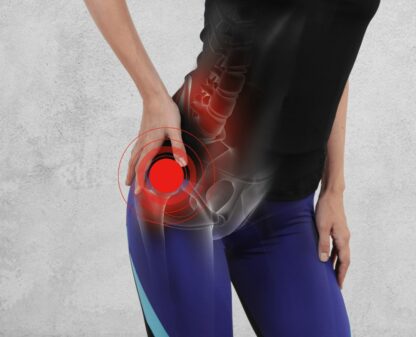Gluteal vs Sham Exercises in Gluteal Tendinopathy

Introduction
Different terminology for basically the same issue: gluteal bursitis, gluteal tendinopathy, greater trochanteric pain syndrome
Greater trochanteric pain syndrome (GTPS) is a prevalent hip complaint in women between 45 and 63 years old. Clear evidence for conservative management to this day remains elusive. Only one study before the publication of the current one investigated an exercise program that was superior in the long term to corticosteroid injections and shockwave. Both eccentric- and heavy slow resistance programs are proved to be useful in other lower limb tendinopathies. Currently, there’s no strong evidence for exercise against a worthy sham intervention. This study aims to fill that evidence gap.
Methods
A participant-blinded controlled trial was held with 12 weeks as a primary outcome point and a follow-up to 52 weeks. Patients that received a local injection in the last 12 weeks, underwent surgery on the affected side, or had any other MSK, neurological, or cardiorespiratory condition affecting their ability to participate, were excluded. Patients were included after an a priori power analysis and randomized into either a gluteal loading program or a sham exercise program, both groups received education about GTPS. The information included general gluteal tendinopathy info such as; the nature of tendinopathies, advice on how to sit, sleep and stand with minimal provocation, as well as reassurance to stay active.
The targeted gluteal group performed the exercises below:

The sham exercise group, however, performed exercises that were unlikely to load the gluteal tendon sufficiently:

Their primary outcome measure was the VISA-G, which is a patient-reported outcome measure for pain and function. Other secondary outcome measures won’t be discussed in detail, as this was not the primary aim of the study and statistical power is lacking.
Results
Both groups improved significantly from baseline at the 12 and 52-week marks in all outcomes except for the LHPQ sports subsection. However, no between-group differences were found for any variable. The study group performed a ‘responder analysis’, meaning participants that reported 5+ points on the global rating of change were analyzed head to head separately from their respective groups. Significant differences were found in favor of the gluteal loading group responders compared to the sham group responders for all outcome measures except the LHPQ sports subsection and the AQOL.
Questions and thoughts
It’s easy to say, “So what? It’s just one trial.” However, we cannot confidently say this won’t be the case in other tendinopathies. There’s not enough data. Does this mean we should never load the affected area? No. Where other tendinopathy trials usually have a higher volume and intensity of specific tendon work, this trial had an arguably low specific tendon volume at low to moderate intensity in the gluteal group. Maybe the stimulus just wasn’t sufficient. Another thing worth mentioning is that exercises were to be performed twice daily, which might be a lot. What results would we get if almost all exercises loaded the gluteal tendon, not just one-third of them? What if we dropped the quadriceps and calf exercises to replace them with glute exercises? Let’s not throw the baby out with the bathwater.
Talk nerdy to me
The overall quality of the study was pretty sound. Participants were blinded for allocation and after one week, no participant was sure of allocation. Study power was calculated a priori to detect a medium standardized effect size (0.8) on the VISA-G. Knowing this, the study was insufficiently powered to detect meaningful changes in any secondary outcome measures or the primary measure besides the 12-week time-point. This could result in type 2 errors, and false negatives. The study did not correct for multiple comparisons, although this would have an effect on mainly type 1 errors. When groups would differ post-randomization, characteristics would be included as covariates in the analyses.
The exercises were administered by 23 different physiotherapists, all of whom received a three-hour training. While the training might be a strength, the fact that there was such a wide variety of physiotherapists might be considered a limitation for internal validity, yet increasing external validity. The exercises in the study were considered strengthening exercises, however, no strength measures were taken at baseline or follow-up. Did they get stronger? Is that necessary?
Considering the exercise program, one could argue that the exercises were no sufficient stimulus for the tendon. Looking at the supplementary data, one gluteal exercise was prescribed for the gluteal exercise group. A progression was made clear and encouraged, however, one exercise (2-4 sets, 5-15 reps, twice daily) might not do it, or the volume in total might be too high. There’s not much data on it. Surely not when considering the trial was held in 2016. The authors based their exercise selection on clinical reasoning and EMG data. The clinical reasoning comes in at the calf and quadriceps exercises, the kinetic chain. Should they have gone for the low-hanging fruit and prescribed higher volumes and/or higher intensity for the gluteal tendon, while ‘ignoring’ the kinetic chain for time purposes? Might the participants be better off with rest days for possible DOMS, collagen response, and time purposes,…? There are a lot of questions, as is with any scientific paper.
Take home messages
- There’s still uncertainty around the specificity of exercise in tendinopathies
- Education might be sufficient since both groups improved equally and had the information booklet in common
- More trials with different parameters needed
Reference
LEVEL UP YOUR DIFFERENTIAL DIAGNOSIS IN RUNNING RELATED HIP PAIN - FOR FREE!
Don’t run the risk of missing out on potential red flags or ending up treating runners based on a wrong diagnosis! This webinar will prevent you to commit the same mistakes many therapists fall victim to!



